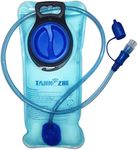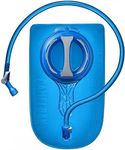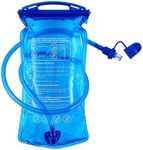Buying Guide for the Best Hydration Bladders
Hydration bladders are a convenient way to carry and access water while on the go, especially during activities like hiking, cycling, or running. They allow you to drink hands-free, which can be a significant advantage in maintaining hydration without interrupting your activity. When choosing a hydration bladder, consider factors such as capacity, material, ease of cleaning, and compatibility with your backpack or hydration pack. Understanding these key specifications will help you select a bladder that best suits your needs and preferences.CapacityCapacity refers to the amount of water a hydration bladder can hold, typically measured in liters. This is important because it determines how much water you can carry with you, which is crucial for staying hydrated during your activity. Bladders usually range from 1 to 3 liters. A 1-liter bladder is suitable for short activities or when you have access to refill stations. A 2-liter bladder is a versatile choice for moderate activities, while a 3-liter bladder is ideal for long hikes or when water sources are scarce. Choose a capacity based on the duration of your activity and your personal hydration needs.
MaterialThe material of a hydration bladder affects its durability, weight, and taste of the water. Common materials include polyurethane and polyethylene. Polyurethane is flexible and durable, making it a popular choice, but it can sometimes impart a plastic taste to the water. Polyethylene is lighter and often has a more neutral taste, but it may not be as durable. Consider how important weight and taste are to you, as well as how rough you might be on your gear, when choosing the material.
Ease of CleaningEase of cleaning is crucial for maintaining hygiene and preventing mold or bacteria growth in your hydration bladder. Some bladders have wide openings that make them easier to clean and dry, while others may have more complex designs that require special brushes or cleaning kits. If you plan to use your bladder frequently or with different types of beverages, opt for one that is easy to clean. Consider how much effort you're willing to put into maintenance when selecting a bladder.
CompatibilityCompatibility refers to how well the hydration bladder fits with your existing backpack or hydration pack. Some bladders are designed to fit specific packs, while others are more universal. It's important to ensure that the bladder you choose will fit comfortably in your pack and that the hose can be easily routed for convenient drinking. Check the dimensions and hose length to ensure a good fit with your gear. If you already have a backpack, make sure the bladder is compatible with it.
Bite ValveThe bite valve is the part of the hydration bladder that you drink from, and its design can affect your drinking experience. A good bite valve should be easy to use, leak-proof, and provide a steady flow of water. Some valves have on/off switches to prevent leaks, while others may have covers to keep them clean. Consider how easy the valve is to use and whether it meets your needs for convenience and hygiene. If you plan to use the bladder in cold conditions, look for a valve that won't freeze easily.















